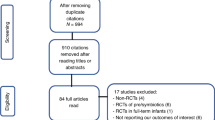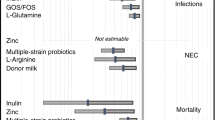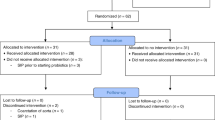Abstract
The pathophysiology of necrotizing enterocolitis (NEC) has not been clearly elucidated, but recent studies support the role of unbalanced pro-inflammatory signaling, leading to intestinal necrosis in premature infants. Although breast milk feeding is thought to reduce the risk of this condition, there are no preventive or therapeutic approaches that have consistently shown to be effective for this common and devastating disease. Recent studies show that probiotic colonization is abnormal in preterm neonates, and enteral supplementation with a variety of probiotic organisms can reduce the risk of disease. This chapter summarizes the current state-of-the-art regarding probiotics and NEC, but suggests caution until appropriately regulated products are available for use in this high-risk population.
This is a preview of subscription content, access via your institution
Access options
Subscribe to this journal
Receive 12 print issues and online access
$259.00 per year
only $21.58 per issue
Buy this article
- Purchase on Springer Link
- Instant access to full article PDF
Prices may be subject to local taxes which are calculated during checkout


Similar content being viewed by others
References
Kliegman RM . Models of the pathogenesis of necrotizing enterocolitis. J Pediatr 1990; 117 (1 Part 2): S2–S5.
Blakely ML, Tyson JE, Lally KP, McDonald S, Stoll BJ, Stevenson DK et al. Laparotomy versus peritoneal drainage for necrotizing enterocolitis or isolated intestinal perforation in extremely low birth weight infants: outcomes through 18 months adjusted age. Pediatrics 2006; 117: e680–e687.
Lucas A, Cole TJ . Breast milk and neonatal necrotising enterocolitis. Lancet 1990; 336: 1519–1523.
Uauy RD, Fanaroff AA, Korones SB, Phillips EA, Phillips JB, Wright LL . Necrotizing enterocolitis in very low birth weight infants: biodemographic and clinical correlates. National Institute of Child Health and Human Development Neonatal Research Network. J Pediatr 1991; 119: 630–638.
Siu YK, Ng PC, Fung SC, Lee CH, Wong MY, Fok TF et al. Double blind, randomised, placebo controlled study of oral vancomycin in prevention of necrotising enterocolitis in preterm, very low birthweight infants. Arch Dis Child Fetal Neonatal Ed 1998; 79: F105–F109.
Halac E, Halac J, Begue EF, Casanas JM, Indiveri DR, Petit JF et al. Prenatal and postnatal corticosteroid therapy to prevent neonatal necrotizing enterocolitis: a controlled trial. J Pediatr 1990; 117: 132–138.
Eibl MM, Wolf HM, Furnkranz H, Rosenkranz A . Prevention of necrotizing enterocolitis in low-birth-weight infants by IgA–IgG feeding. N Engl J Med 1988; 319: 1–7.
Okuyama H, Kubota A, Oue T, Kuroda S, Ikegami R, Kamiyama M . A comparison of the clinical presentation and outcome of focal intestinal perforation and necrotizing enterocolitis in very-low-birth-weight neonates. Pediatr Surg Int 2002; 18: 704–706.
Grosfeld JL, Cheu H, Schlatter M, West KW, Rescorla FJ . Changing trends in necrotizing enterocolitis. Experience with 302 cases in two decades. Ann Surg 1991; 214: 300–306; discussion 306–307.
Bisquera JA, Cooper TR, Berseth CL . Impact of necrotizing enterocolitis on length of stay and hospital charges in very low birth weight infants. Pediatrics 2002; 109: 423–428.
Hintz SR, Kendrick DE, Stoll BJ, Vohr BR, Fanaroff AA, Donovan EF et al. Neurodevelopmental and growth outcomes of extremely low birth weight infants after necrotizing enterocolitis. Pediatrics 2005; 115: 696–703.
Caplan MS, Jilling T . New concepts in necrotizing enterocolitis. Curr Opin Pediatr 2001; 13: 111–115.
Walker WA . The dynamic effects of breastfeeding on intestinal development and host defense. Adv Exp Med Biol 2004; 554: 155–170.
Caplan MS, MacKendrick W . Necrotizing enterocolitis: a review of pathogenetic mechanisms and implications for prevention. Pediatr Pathol 1993; 13: 357–369.
Ford H, Watkins S, Reblock K, Rowe M . The role of inflammatory cytokines and nitric oxide in the pathogenesis of necrotizing enterocolitis. J Pediatr Surg 1997; 32: 275–282.
Dvorak B, Halpern MD, Holubec H, Williams CS, McWilliam DL, Dominguez JA et al. Epidermal growth factor reduces the development of necrotizing enterocolitis in a neonatal rat model. Am J Physiol Gastrointest Liver Physiol 2002; 282: G156–G164.
Caplan MS, Sun XM, Hsueh W . Hypoxia, PAF, and necrotizing enterocolitis. Lipids 1991; 26: 1340–1343.
Caplan M, Hsueh W, Kelly A, Donovan M . Serum PAF acetylhydrolase increases during neonatal maturation. Prostaglandins 1990; 39: 705–714.
Wang H, Tan X, Chang H, Gonzalez-Crussi F, Remick DG, Hsueh W . Regulation of platelet-activating factor receptor gene expression in vivo by endotoxin, platelet-activating factor and endogenous tumour necrosis factor. Biochem J 1997; 322: 603–608.
Jilling T, Lu J, Jackson M, Caplan MS . Intestinal epithelial apoptosis initiates gross bowel necrosis in an experimental model of neonatal necrotizing enterocolitis. Pediatr Res 2004; 55 (Suppl 4): 622–629.
Akira S . Toll-like receptor signaling. J Biol Chem 2003; 278: 38105–38108.
Akira S, Yamamoto M, Takeda K . Role of adapters in Toll-like receptor signalling. Biochem Soc Trans 2003; 31: 637–642.
Jilling T, Simon D, Lu J, Meng FJ, Li D, Schy R et al. The roles of bacteria and TLR4 in rat and murine models of necrotizing enterocolitis. J Immunol 2006; 177: 3273–3282.
Leaphart CL, Cavallo J, Gribar SC, Cetin S, Li J, Branca MF et al. A critical role for TLR4 in the pathogenesis of necrotizing enterocolitis by modulating intestinal injury and repair. J Immunol 2007; 179: 4808–4820.
Walker WA, Duffy LC . Diet and bacterial colonization: role of probiotics and prebiotics. J Nutr Biochem 1998; 9: 668–675.
Tannock GW . Can the gut microflora of infants be modified by giving probiotics to mothers? J Pediatr Gastroenterol Nutr 2004; 38: 244–246.
Gewolb IH, Schwalbe RS, Taciak VL, Harrison TS, Panigrahi P . Stool microflora in extremely low birthweight infants. Arch Dis Child Fetal Neonatal Ed 1999; 80: F167–F173.
Hoyos AB . Reduced incidence of necrotizing enterocolitis associated with enteral administration of Lactobacillus acidophilus and Bifidobacterium infantis to neonates in an intensive care unit. Int J Infect Dis 1999; 3: 197–202.
Dani C, Biadaioli R, Bertini G, Martelli E, Rubaltelli FF . Probiotics feeding in prevention of urinary tract infection, bacterial sepsis and necrotizing enterocolitis in preterm infants. A prospective double-blind study. Biol Neonate 2002; 82: 103–108.
Lin HC, Su BH, Chen AC, Lin TW, Tsai CH, Yeh TF et al. Oral probiotics reduce the incidence and severity of necrotizing enterocolitis in very low birth weight infants. Pediatrics 2005; 115: 1–4.
Bin-Nun A, Bromiker R, Wilschanski M, Kaplan M, Rudensky B, Caplan M et al. Oral probiotics prevent necrotizing enterocolitis in very low birth weight neonates. J Pediatr 2005; 147: 192–196.
Deshpande G, Rao S, Patole S . Probiotics for prevention of necrotising enterocolitis in preterm neonates with very low birthweight: a systematic review of randomised controlled trials. Lancet 2007; 369: 1614–1620.
Sartor RB . Probiotic therapy of intestinal inflammation and infections. Curr Opin Gastroenterol 2005; 21: 44–50.
Caplan MS, Miller-Catchpole R, Kaup S, Russell T, Lickerman M, Amer M et al. Bifidobacterial supplementation reduces the incidence of necrotizing enterocolitis in a neonatal rat model. Gastroenterology 1999; 117: 577–583.
Besselink MG, van Santvoort HC, Buskens E, Boermeester MA, van Goor H, Timmerman HM et al. Probiotic prophylaxis in predicted severe acute pancreatitis: a randomised, double-blind, placebo-controlled trial. Lancet 2008; 371: 651–659.
Honeycutt TC, El Khashab M, Wardrop III RM, McNeal-Trice K, Honeycutt AL, Christy CG et al. Probiotic administration and the incidence of nosocomial infection in pediatric intensive care: a randomized placebo-controlled trial. Pediatr Crit Care Med 2007; 8: 452–458; quiz 464.
Boehm G, Jelinek J, Stahl B, van Laere K, Knol J, Fanaro S et al. Prebiotics in infant formulas. J Clin Gastroenterol 2004; 38: S76–S79.
Dai D, Nanthkumar NN, Newburg DS, Walker WA . Role of oligosaccharides and glycoconjugates in intestinal host defense. J Pediatr Gastroenterol Nutr 2000; 30: S23–S33.
Costalos C, Kapiki A, Apostolou M, Papathoma E . The effect of a prebiotic supplemented formula on growth and stool microbiology of term infants. Early Hum Dev 2008; 84: 45–49.
Moro G, Arslanoglu S, Stahl B, Jelinek J, Wahn U, Boehm GA . Mixture of prebiotic oligosaccharides reduces the incidence of atopic dermatitis during the first six months of age. Arch Dis Child 2006; 91: 814–819.
Author information
Authors and Affiliations
Corresponding author
Rights and permissions
About this article
Cite this article
Caplan, M. Probiotic and prebiotic supplementation for the prevention of neonatal necrotizing enterocolitis. J Perinatol 29 (Suppl 2), S2–S6 (2009). https://doi.org/10.1038/jp.2009.21
Published:
Issue Date:
DOI: https://doi.org/10.1038/jp.2009.21
Keywords
This article is cited by
-
Genome resolved analysis of a premature infant gut microbial community reveals a Varibaculum cambriense genome and a shift towards fermentation-based metabolism during the third week of life
Microbiome (2013)
-
Fulminant necrotizing enterocolitis in a multihospital healthcare system
Journal of Perinatology (2012)
-
Microecology, intestinal epithelial barrier and necrotizing enterocolitis
Pediatric Surgery International (2010)
-
Novel perspectives in probiotic treatment: the efficacy and unveiled mechanisms of the physiological functions
Clinical Journal of Gastroenterology (2010)



